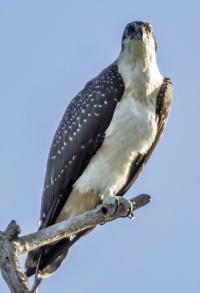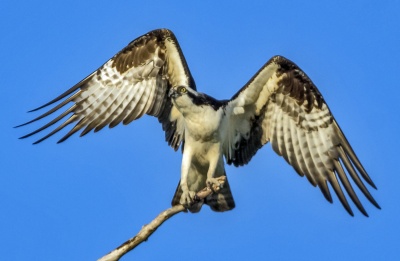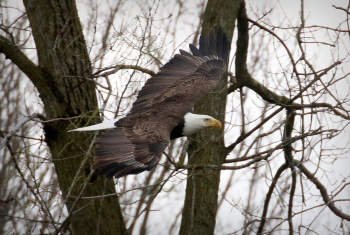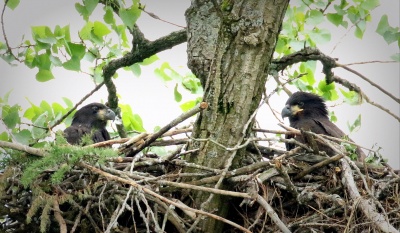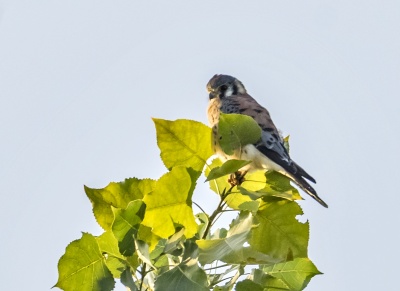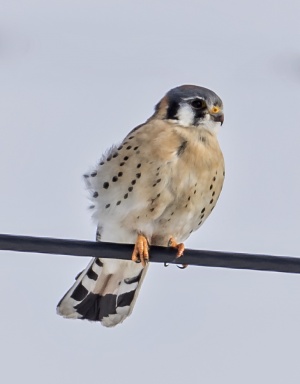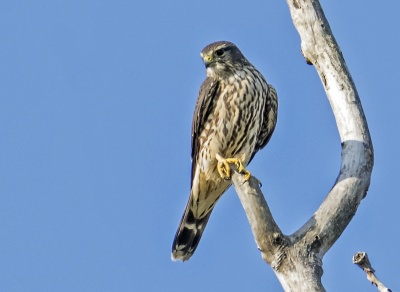Difference between revisions of "Raptors"
Ken Czworka (talk | contribs) (→American Kestrel) |
Ken Czworka (talk | contribs) (→American Kestrel) |
||
| Line 44: | Line 44: | ||
American Kestrels occupy habitats ranging from deserts and grasslands to alpine meadows. You’re most likely to see them perching on telephone wires along roadsides, in open country with short vegetation and few trees. | American Kestrels occupy habitats ranging from deserts and grasslands to alpine meadows. You’re most likely to see them perching on telephone wires along roadsides, in open country with short vegetation and few trees. | ||
| − | [[File:Kestrel1.jpg| | + | [[File:Kestrel1.jpg|400px|thumb|left|Osprey (Pandion haliaetus) - © Ken Czworka]] |
| − | [[File:Kestrel2.jpg| | + | [[File:Kestrel2.jpg|300px|thumb|center|Osprey (Pandion haliaetus) - © Ken Czworka]] |
=== Perigrine Falcon === | === Perigrine Falcon === | ||
Revision as of 13:39, 12 February 2022
|
|
Local raptors include osprey, eagles, falcons, hawks, barn owls, and typical owls.
Contents
Osprey
Osprey
(Pandion haliaetus)
Length: 20"-25"; Wingspan: 59"-67"
Large, mostly white raptor that cruises over lakes, rivers, and coastal waterways in search of fish. Impressively widespread: found on every continent except Antarctica. Mostly white head and underparts; dark brown back. In flight, holds wings with a kink in the wrist (shaped like an "M"). Stick nests are conspicuous on top of channel markers, utility poles and high platforms near water. Often seen plunging feet-first into water from high in the air to grab fish.
Nests used every year can be found at Tifft Nature Preserve and Beaver Island State Park
Eagles
Bald Eagle
(Haliaeetus leucocephalus)
Efforts by the New York State Department of Environmental Conservation and other concerned groups have been so successful that the bald eagle has been removed from the Federal and New York State Endangered Species List. Its status in New York has been changed from Endangered to Threatened.
In 2017, there were approximately 426 occupied bald eagle nest sites of which 48 failed (did not fledge young). However, success has increased in following years. There are many sites on public land. During the non-breeding season, Bald Eagles are found throughout the state, but they tend to concentrate at wintering areas and roosts at about four open water sites in the state. While breeding and wintering populations are increasing in New York they are still faced with many threats including development, human disturbances, contaminated food base, and collision with high speed trains, towers, wind generators, and electrical lines.
Golden Eagle
(Aquila chrysaetos)
Falcons
American Kestrel
(Falco sparverius)
COMMON: Year round resident in all of Western New York. North America's smallest falcon. The slender American Kestrel is roughly the size and shape of a Mourning Dove, although it has a larger head; longer, narrow wings; and long, square-tipped tail. In flight, the wings are often bent and the wingtips swept back.
American Kestrels are pale when seen from below and warm, rusty brown spotted with black above, with a black band near the tip of the tail. Males have slate-blue wings; females’ wings are reddish brown. Both sexes have pairs of black vertical slashes on the sides of their pale faces—sometimes called a “mustache” and a “sideburn."
American Kestrels usually snatch their victims from the ground, though some catch quarry on the wing. They are gracefully buoyant in flight, and are small enough to get tossed around in the wind. When perched, kestrels often pump their tails as if they are trying to balance.
American Kestrels occupy habitats ranging from deserts and grasslands to alpine meadows. You’re most likely to see them perching on telephone wires along roadsides, in open country with short vegetation and few trees.
Perigrine Falcon
(Falco mexicanus)
Merlin
(Falco columbarius)
Small and fierce falcon. Dark above and paler below, with streaking on the underparts; darkness of plumage varies geographically. Feeds mainly on birds captured in flight. Found in a variety of habitats from grasslands, open forests, and especially coastal areas with shorebirds. In flight, note powerful flight, pointed wings, and quick, continuous wingbeats.
Hawks
For the article on hawks, click here.
Owls
For the article on owls, click here.
